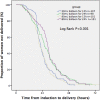Foley Catheter for Induction of Labor at Term: An Open-Label, Randomized Controlled Trial
- PMID: 26322635
- PMCID: PMC4556187
- DOI: 10.1371/journal.pone.0136856
Foley Catheter for Induction of Labor at Term: An Open-Label, Randomized Controlled Trial
Abstract
Objective: This study aimed to determine the optimal Foley catheter balloon volume (30-mL vs. 80-mL) and the maximum time for cervical ripening (12 hours vs. 24 hours) to improve vaginal delivery rate within 24 hours of induction.
Methods: We conducted an open-label, randomized controlled trial in a teaching hospital in China. Women with a term singleton pregnancy, cephalic presentation, intact membrane and an unfavorable cervix (Bishop score <6) were randomly allocated, in 1:1:1:1 ratio, to receive either one of the four treatments: (1) 30-mL balloon for a maximum of 12 hours, (2) 30-mL balloon for a maximum of 24 hours, (3) 80-mL balloon for a maximum of 12 hours, and (4) 80-mL balloon for a maximum of 24 hours. The primary outcome was vaginal delivery within 24 hours. Secondary outcomes included cesarean section rate and maternal/neonatal morbidity. Data were analyzed on a per-protocol basis.
Results: Five hundred and four women were recruited and randomized (126 women in each group); nine women did not receive the assigned intervention. More women achieved vaginal delivery within 24 hours in 12-hour Foley catheter groups than in the 24-hour Foley catheter groups (30-mL/12 hours: 54.5%, 30-mL/24 hours: 33.1%, 80-mL/12 hours: 46.4%, 80-mL/24 hours: 24.0%, p < 0.001). Cesarean section rates and the incidence of chorioaminonitis were comparable among four groups. After adjustment for confounding factors, both ripening time and balloon size did not affect the proportion of women delivered vaginally within 24 hours of induction.
Conclusion: For women with an unfavorable cervix at term, induction of labor with a Foley catheter is safe and effective. Higher balloon volume (80-mL vs. 30-mL) and longer ripening time (24 hours vs. 12 hours) would not shorten induction to delivery interval or reduce cesarean section rate.
Trial registration: Chinese Clinical trial registry (ChiCTR-TRC-13003044).
Conflict of interest statement
Figures




References
-
- Jozwiak M, Bloemenkamp KW, Kelly AJ, Mol BW, Irion O, Boulvain M. Mechanical methods for induction of labour. Cochrane Database Syst Rev. 2012; 14: 3: CD001233. - PubMed
-
- Pennell CE, Henderson JJ, O’Neill MJ, McCleery S, Doherty DA, Dickinson JE. Induction of labour in nulliparous women with an unfavourable cervix: a randomised controlled trial comparing double and single balloon catheters and PGE2 gel. BJOG. 2009; 116: 1443–1452. 10.1111/j.1471-0528.2009.02279.x - DOI - PubMed
-
- Jozwiak M, Rengerink KO, Benthem M, van Beek E, Dijksterhuis MG, de Graaf IM, et al. Foley catheter versus vaginal prostaglandin E2 gel for induction of labour at term (PROBAAT trial): an open-label, randomised controlled trial. Lancet. 2011; 378: 9809: 2095–2103. - PubMed
Publication types
MeSH terms
Associated data
LinkOut - more resources
Full Text Sources
Other Literature Sources

